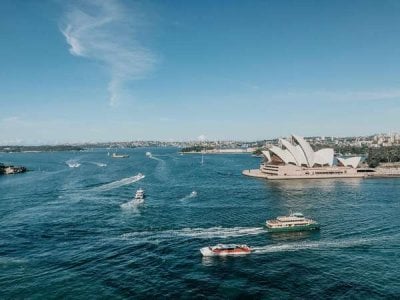Discover the Stunning Future of Sydney's Waterfront: Iconic Ferries to Go Electric!
By
Danielle F.
- Replies 5
Sydney's waterfront is set to embrace a new era of transport, as the city's beloved ferries prepare to make a significant leap into the future. The iconic vessels that have long been a staple of Sydney Harbour's picturesque landscape are undergoing a transformation, with plans to replace them with cutting-edge electric, zero-emission vessels. This move not only represents a commitment to sustainability but also promises to enhance the experience for the hundreds of tourists and commuters who rely on these ferries every day.
The market sounding process has already commenced, signaling the start of a journey towards a greener, more efficient fleet. Transport for NSW is actively collaborating with local businesses to spearhead the development of these next-generation vessels. This initiative is not just about adopting new technology; it's about investing in the local economy and fostering innovation within the Australian maritime industry.
One of the most exciting features of the new electric ferries is the introduction of dual-level boarding. This design innovation is expected to significantly streamline the boarding process, allowing crowds to embark and disembark with greater ease and speed. Such improvements are crucial for maintaining the flow of daily life in Sydney, where the ferries are more than just a tourist attraction—they're an integral part of the city's transport infrastructure.
The conversation around the new ferries has also sparked interest in preserving the heritage and aesthetic that Sydney's ferries are known for. Save the Manly Ferry Committee councillor Candy Bingham has advocated for the new vessels to be 'look alikes' of the Freshwater Manly Ferries. However, she also recognizes the practical benefits of a slight reduction in size, which would allow for more convenient maintenance and reduce service interruptions.
The current ferries require major maintenance at the Australian Navy's Captain Cook Graving Dock, but smaller vessels could utilize facilities like the NSW Government-owned Balmain Shipyard. This shift could mean more consistent service for the Manly route and less downtime for these crucial vessels.
NSW Transport Minister Jo Haylen has emphasized the need for 'high-capacity, reliable vessels' to serve the bustling Manly route. She reflects on the evolution of Sydney's ferries—from steamships to diesel-powered and now towards modern electric vessels. While the Freshwater vessels have been given an extended lease on life, planning for the future fleet is a priority.
The Emerald IIs, which were built overseas, have faced challenges with Sydney's conditions, particularly with loading efficiency due to their single gangway design. The new electric ferries aim to address these issues, combining the legacy of the Freshwaters with the capacity the community needs and the benefits of zero-emission propulsion.
An expected timeline for the introduction of the brand new ferries will be announced following the market sounding process. However, the current diesel-powered vessels are anticipated to be replaced by 2035. In the meantime, Transport for NSW is also looking to trial an electric-powered Parramatta River Class vessel by the end of 2026, marking a significant milestone as the first of its kind.
As we look forward to the arrival of these innovative electric ferries, we can't help but feel a sense of excitement for what this means for Sydney's waterfront. The city is poised to set a global example in sustainable maritime transport, all while preserving the charm and history that make the Sydney ferries so iconic.

We invite our readers to share their thoughts and experiences with Sydney's ferries. What memories do you hold dear from your journeys across the harbour, and how do you feel about this transition to electric vessels? Your insights are valuable as we navigate these changing tides together.
The market sounding process has already commenced, signaling the start of a journey towards a greener, more efficient fleet. Transport for NSW is actively collaborating with local businesses to spearhead the development of these next-generation vessels. This initiative is not just about adopting new technology; it's about investing in the local economy and fostering innovation within the Australian maritime industry.
One of the most exciting features of the new electric ferries is the introduction of dual-level boarding. This design innovation is expected to significantly streamline the boarding process, allowing crowds to embark and disembark with greater ease and speed. Such improvements are crucial for maintaining the flow of daily life in Sydney, where the ferries are more than just a tourist attraction—they're an integral part of the city's transport infrastructure.
The conversation around the new ferries has also sparked interest in preserving the heritage and aesthetic that Sydney's ferries are known for. Save the Manly Ferry Committee councillor Candy Bingham has advocated for the new vessels to be 'look alikes' of the Freshwater Manly Ferries. However, she also recognizes the practical benefits of a slight reduction in size, which would allow for more convenient maintenance and reduce service interruptions.
The current ferries require major maintenance at the Australian Navy's Captain Cook Graving Dock, but smaller vessels could utilize facilities like the NSW Government-owned Balmain Shipyard. This shift could mean more consistent service for the Manly route and less downtime for these crucial vessels.
NSW Transport Minister Jo Haylen has emphasized the need for 'high-capacity, reliable vessels' to serve the bustling Manly route. She reflects on the evolution of Sydney's ferries—from steamships to diesel-powered and now towards modern electric vessels. While the Freshwater vessels have been given an extended lease on life, planning for the future fleet is a priority.
The Emerald IIs, which were built overseas, have faced challenges with Sydney's conditions, particularly with loading efficiency due to their single gangway design. The new electric ferries aim to address these issues, combining the legacy of the Freshwaters with the capacity the community needs and the benefits of zero-emission propulsion.
An expected timeline for the introduction of the brand new ferries will be announced following the market sounding process. However, the current diesel-powered vessels are anticipated to be replaced by 2035. In the meantime, Transport for NSW is also looking to trial an electric-powered Parramatta River Class vessel by the end of 2026, marking a significant milestone as the first of its kind.
As we look forward to the arrival of these innovative electric ferries, we can't help but feel a sense of excitement for what this means for Sydney's waterfront. The city is poised to set a global example in sustainable maritime transport, all while preserving the charm and history that make the Sydney ferries so iconic.
Key Takeaways
- Iconic Sydney ferries, integral for daily transport for tourists and commuters, will be transformed into electric, zero-emission vessels.
- The procurement process has begun to ensure these new ferries are locally manufactured, with Transport for NSW collaborating with local firms.
- The upgrades include dual-level boarding for efficient passenger movement, and there's a community desire for new ferries to resemble the historic Freshwater class while potentially being smaller to ease maintenance requirements.
- NSW Transport Minister Jo Haylen emphasized the need for reliable, high-capacity electric ferries to maintain the Manly route's legacy, with a shift from historic steam and diesel vessels to modern, environmentally friendly transportation. The timeline for introduction of the new vessels will be clarified after the market procurement process, aiming to replace the current fleet by 2035, and trials for an electric-powered river vessel are anticipated as early as the end of 2026.








